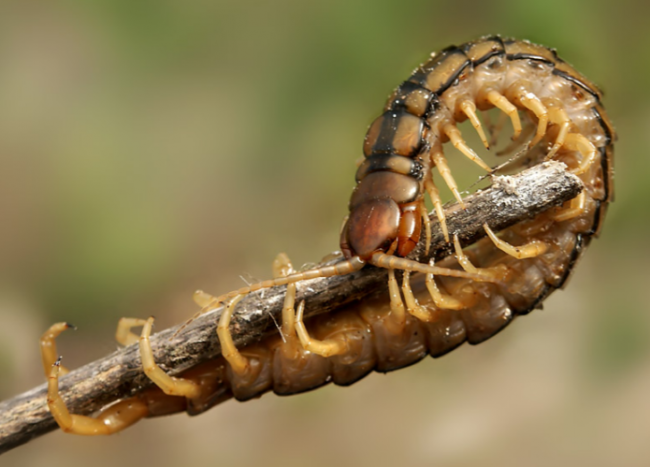
Classification
Genus: Scolopendras
Family: Scolopendridae
Order: Scolopendra
Class: Lepodoptera
Type: Arthropods
Kingdom: Animals
Scolopendra looks pretty intimidating, but for a person it’s not poses a great danger. She moves quickly and gracefully can jump and move side and back direction.
Skolopendra has several names – the common flycatcher, millipede, long-legged arachnid, scooter. Squad scooters includes approximately 100 species that are common in southern latitudes.
Content
- 1 Features of the structure
- 2 Lifestyle
- 3 Features of reproduction
- 4 Scolopendra content
- 5 captive breeding
- 6 Scolopendra Diseases
- 7 Danger to humans
- 8 Features of the giant scolopendra
Structural features
Contents
Millipede breathing is realized by trachea. To save moisture in the process of breathing, spiracles lead into air sacs, and from they originate from the trachea.
The integument of the body of the scolopendra also protects it from moisture loss, because they are covered with epicuticle, which is flexible and ability to repel moisture. The outer skeleton of this arthropod consists of chitin and sclerotin.
Also, the flycatcher has simple eyes in large numbers and closely adjacent to each other. It is characterized by the presence of 15 pairs articulated legs of pronounced length, making it the fastest among the scooter and allows you to navigate vertically surfaces.
In a home scolopendra, the back pair of legs may exceed the length torso in length. The scooters have a long antennae in front form of whips – they perform olfactory and tactile functions. They consist of 500-600 segments.
The front legs are turned into the jaw, with their help scolopendra captures prey and injects poison into her body. However, the jaw of this scooter is not strong enough, therefore she will not be able to bite through human skin, and her poison has a small toxicity.
Millipede is not aggressive in relation to to man.
If the scolopendra, or scooter, has settled in the house, then you can to be sure that flies and cockroaches will soon cease disturb the owners.
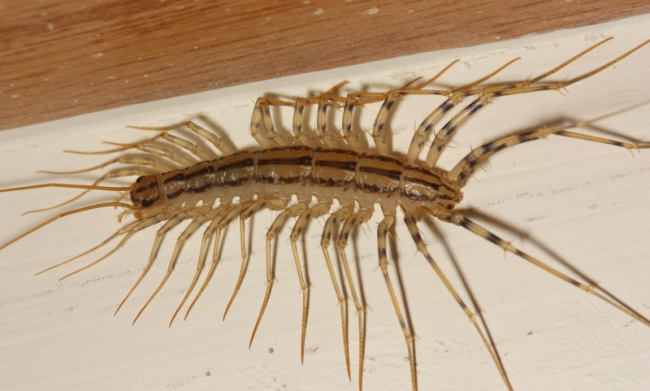
Home scolopendra can live in nooks and crannies, and at night – crawl onto your pillow
The body length of an adult reaches 60 mm. Scolopendra yellowish gray or brown, also has three red-violet or bluish stripes along the body, legs while also striped.
The body is flattened and divided into 15 segments, for each of which a pair of legs is provided.
Lifestyle
A flycatcher is a predator and can prey on cockroaches, flies, termites, silverfish, fleas, spiders, moths. She is very fast moves, the speed of its movement can be up to 40 cm in give me a sec. Excellent eyesight makes her an excellent night the hunter.
All scolopendras (and there are about a hundred of them) have a similar structure body divided into segments. However, the species differ in size and color.
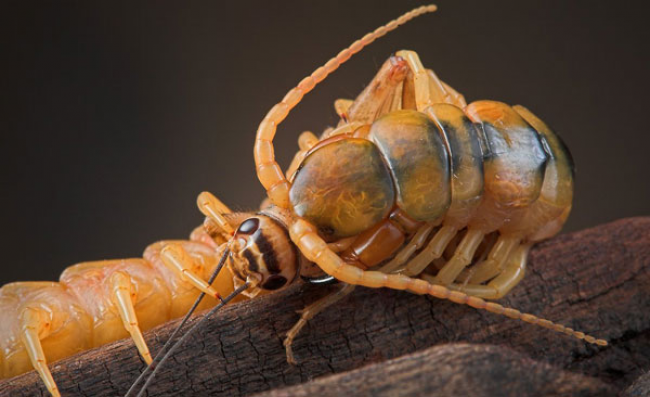
Scooters’ jawbone is a great helper when hunting
Scolopendras hunt more often at night, but can conduct hunting and in the afternoon. At night they eat sleeping insects, and in the daytime sit out in shelters.
When hunting, a centipede knocks down a victim with the help of legs, after which they also capture. In some cases, it catches several insects, eating one and holding legs the rest.
When trying to catch a scooter, she may sacrifice her legs for having to break free. The latter may grow in part or completely. In autumn, the scolopendra can move into residential houses.

A home centipede is harmless to humans

The black millipede is another scooter squad
Propagation Features
Scooters breed in the warmer months when conditions most favorable. Scolopendra mating behavior is pretty interesting.
Before contact, the female and the male should feel each other with help antennae. Otherwise, the female may perceive the male as a victim and attack him.
The method of fertilization in millipedes is external-internal. Important while the female should capture the spermatophore as soon as possible male so that he was in the air for a split second. For this, the male pushes the female towards the spermatophore.
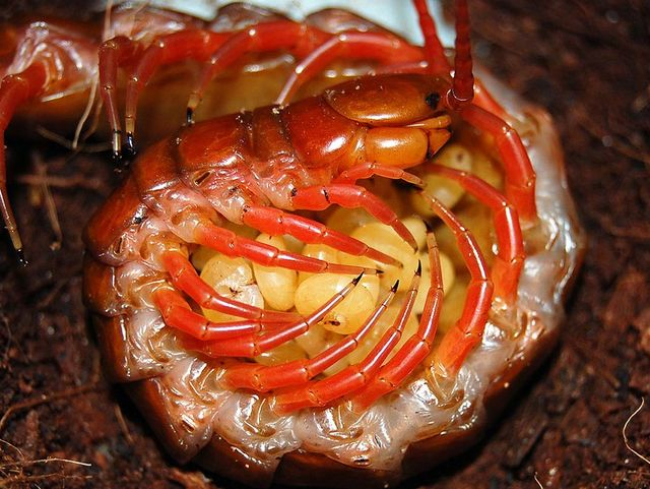
Flytrap egg laying
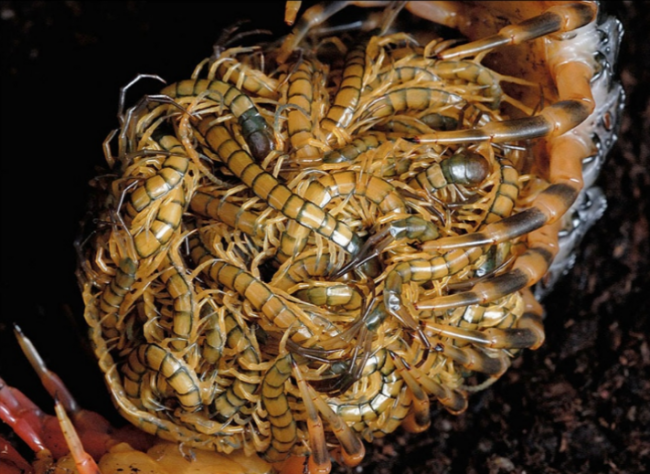
Kids are developing very fast.
The female lays eggs one at a time, but in total – about 60. After that, it covers the masonry with a sticky substance for protection. After hatching, it can be noted that the young individual differs from the adult in the number of pairs of legs – she has only 4 of them.
The number of pairs of legs increases with each molt to the final numbers – 15 pairs. In total, the scolopendra goes through five consecutive links. Flycatchers have a life span of 3 to 7 years old.
Scolopendra content
The content of scolopendras is not particularly difficult. Important not to allow arthropod to escape from the terrarium. Millipede is extremely active creature and capable of skillfully making shoots.
It is recommended that these animals be kept in high terrariums, as and chameleons, pythons and geckos, due to the need for data animals in a specific microclimate.
The material should not be thin plastic, so that they do not gnaw exit. In addition, it is important to apply optimal lighting.
It should be borne in mind that scolopendras are extremely fond of making burrows. Therefore, the bottom of the terrarium needs to be covered with something. Can mix peat, vermiculite and earth (10/20/70), this composition is suitable for tropical species, and you can mix sand and earth in half – for desert species.
The temperature in the terrarium should be about 22 degrees during the day and 19 – at night. Shelter needs to be equipped in the terrarium. Periodically Terrarium must be sprayed to create moisture. In capacity There should always be a drinking bowl with settled water.
Since scolopendras are hunters, in captivity it is necessary feed them with grasshoppers, cicadas, crickets, for a giant species of this millipede may be required and the mouse. Feeding should be done once or twice a week. If a the animal does not eat, most likely molting will come soon.
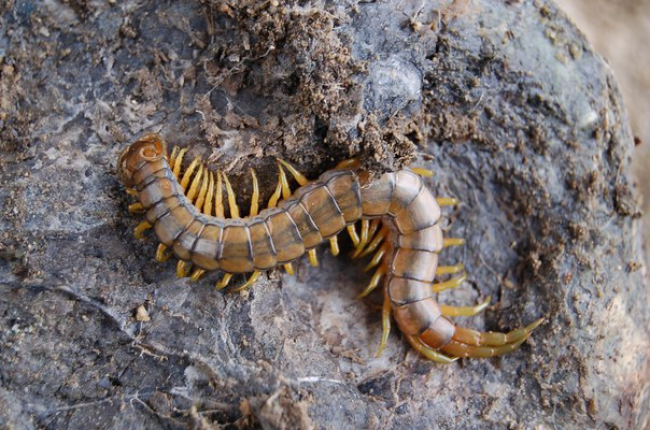
Giant Scolopendra in the wild
Before molting, the color of the millipede darkens. Molting process lasts from minutes to hours, which is determined by the size of the individual. After molting, the animals are pretty defenseless because their exoskeleton becomes soft and vulnerable.
Within two weeks, the exoskeleton solidifies. IN this period is worth being careful with feeding: some insects can damage the scolopendra.
Captive breeding
Breeding scolopendra in captivity is a rather complicated matter. Individuals can reach puberty in 1-4 years. Pretty hard determine the gender of the individual. Some advise to pay attention to terminal pair of legs – in males they are longer, and in females – fatter.
You should also observe the interaction of individuals who are in one container: same-sex creatures will manifest aggression, and heterosexual usually behave passively.
After mating, the female lays eggs, at this time it is necessary to place the terrarium in a dark place and leave the animal in alone: if an individual feels threatened, it can eat eggs.
After 5-6 weeks, the appearance of protonyms from eggs, and then, also after the same time, their first molting, after which it is necessary to deposit them from the mother individuals.
Feeding should be done with insects smaller at least twice the size. Small scolopendras should be fed dead insects twice a week, as the individual grows you need to give her small crickets, grasshoppers.
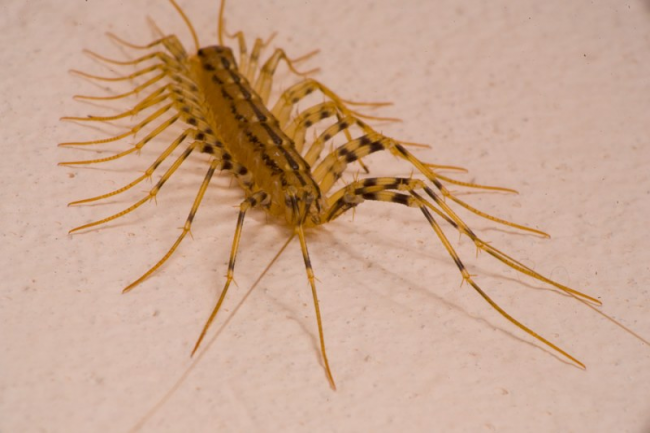
A home flycatcher is intimidating but not dangerous. Despite name, it is not a pet, but can just live in an apartment, along with other insects such as cockroaches. As large, “beautiful” species are usually taken from a pet scolopendra
Scolopendra Disease
When breeding these insects, you may encounter the following diseases:
- Dehydration. To prevent this, it is necessary to spray terrarium and keep an open container of water in it.
- Tick infection. To eliminate them, you must move individual in a dry place, set there a small vessel with water, ticks will die.
- Mycoses. They arise due to an excess of moisture and appear in the form black dots on the legs of a scolopendra. To get rid of pathology, humidity in the terrarium should be adjusted.
Thus, breeding scolopendras in captivity is an occupation, albeit uncomplicated, but rather troublesome. Features to consider feeding, breeding, molting millipedes: then these creatures will comfortable in a terrarium.
It is necessary to pay special attention to the contents of the tank, where live scolopendra: different species of this animal prefer different conditions. It’s important to choose the optimal mix in the terrarium, also pay attention to humidity and temperature.
Feeding should be done no more than twice a week, and in the period after molting to give to scolopendra only small insects, which cannot damage her unprotected exoskeleton.
With all the recommendations, it is possible to observe interesting and active life of millipedes.
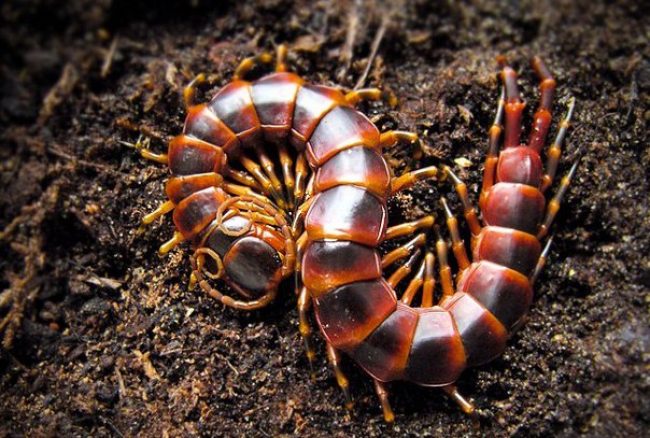
All members of the squad squad love moisture.
Danger to humans
If a flycatcher lives in an apartment or house, she will not inflict harm neither food nor furniture. Not typical for scolopendras aggressive behavior, they can only bite a person with self-defense.
A bite of a home scolopendra is not dangerous – their poison rather weak, the bite site hurts much less than, for example, with bee sting.
The venom of this arthropod is not a serious danger and for pets – cats or dogs. Due to the ability to insect killing, scolopendra are beneficial for humans, but many decide to destroy them, since millipedes are different pretty unpleasant appearance.
In some countries, scolopendra, on the contrary, is protected.
However, if you got a scolopendra as a pet, then you should not let her out and even more so contact her. The fact is that large individuals have strong stings that can kill even a rodent like a rat or lemming.
Such individuals are truly dangerous to human health, therefore must be isolated in the terrarium.
Features of a giant scolopendra
The body length of a giant scolopendra is about 26 cm, It is distributed in South America, on the islands of Trinidad and Jamaica. Giant scolopendra can attack lizards, birds, toads and mice.
The poison is more active in females. Some mistakenly believe that poison Scolopendra is deadly to humans, but it is not.
The body of a giant individual includes 21-23 segments, its color copper-red or brown, for each segment a pair is provided legs bright yellow. One pair of legs transformed into jaw and has claws that are connected to glands, secreting poison.
The back pair is represented by dragging legs necessary for facilitate the movement of arthropods in earthen passages.
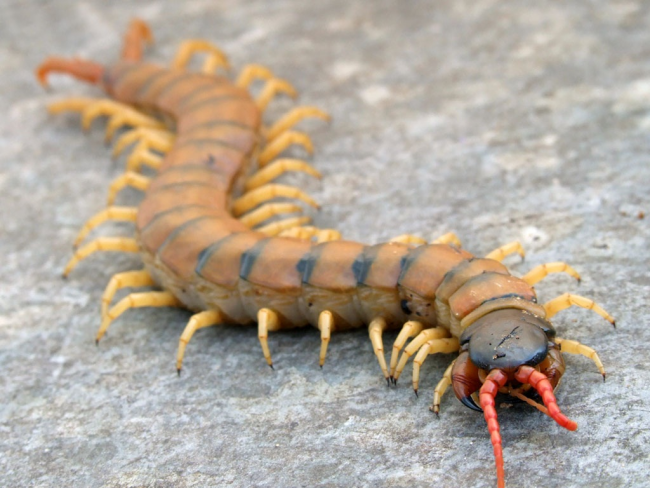
The appearance of the giant scolopendra is quite intriguing
Scolopendra captures the victim with the front pair of legs, injects poison into it and chews. Digestion of food carried out under the influence of strong enzymes.
Scolopendra venom contains substances such as thermolysins, histamine, hyaluronidase, lecithin, serotonin, acetylcholine. When bitten a person can observe local swelling and pain, which lasts for 1-2 hours.
If the individual is quite large, symptoms may remain in for several days, with fever and worsening general somatic state.
https://www.youtube.com/watch?v=woA_osr3AJc?rel=0&enablejsapi=1″style = “border: none;” ebkitAllowFullScreen mozallowfullscreen allowFullScreen>Scolopendra: Pet that trembles
Scolopendra is a fairly common arthropod and belongs to the squadger squad. The lifestyle of this millipede involves hunting for flies, cockroaches and other insects. Flytrap does not pose a danger to humans.






